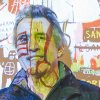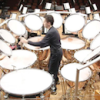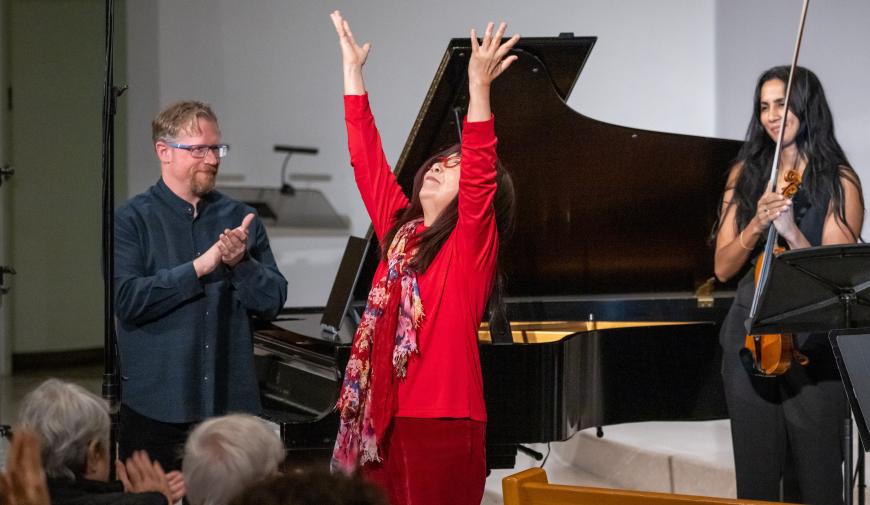
Wildflowers are not the only thing experiencing a super bloom this spring in Southern California. Over the course of four days (April 13–16), the Hear Now Music Festival and Jacaranda Music presented five concerts featuring 29 compositions by 19 different composers, many of which were world premieres. And just within the two concerts I attended (Jacaranda on April 15 and Hear Now on April 16), the range of musical expression was amazingly expansive and international in scope.
Those two programs also paid homage to William Kraft, who was born in 1923 and died in 2022, leaving a lasting legacy of original compositions, decades of performances as principal timpanist of the Los Angeles Philharmonic, and the creation of the LA Phil New Music Group (which later sprouted the Green Umbrella concerts). As aptly stated by Jacaranda’s artistic and executive director, Patrick Scott, the composers of today owe a debt of gratitude to Bill Kraft for paving the way.
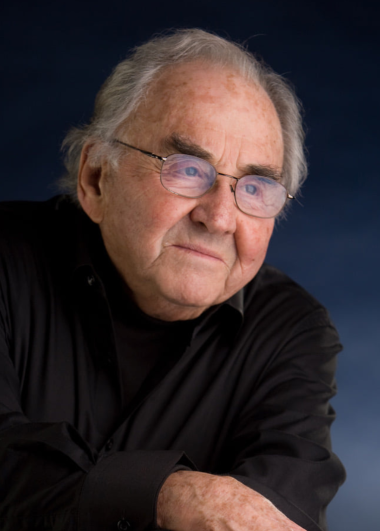
Like so many composers, Kraft died leaving sketches of a never-completed composition — Mosaics, which he envisioned as a companion piece to his 2015 instrumental miniature, Kaleidoscope.
As described by Kraft’s wife of 30 years, the composer Joan Huang, “Mosaics is the result of my process assembling Bill’s puzzle-like sketches, kaleidoscopic patterns, musical phrases, and compositional gestures. For example, I found one penciled manuscript of a piano solo passage which he called ‘Meditating.’ I imagined him, in the early morning, sitting in front of the piano, musing. Meanwhile mourning doves were singing and wind chimes in the garden were swinging. Bill was a jazz musician from early on. He loved ‘free-form’ musical structure. I kept this in my mind in order to make Mosaics as close as possible to Bill’s aesthetic.”
Written for flute, clarinet, violin, cello, percussion, and piano, Mosaics, as its title implies, consists of three distinct sections built upon a succession of fragments. The overall mood is atmospheric and translucent, while the coloration within each “mosaic” can shimmer (in the high-low pairings of bass clarinet and piccolo) and or turn ghostly (with wisps of haunting melody from the piano and marimba). As performed for Jacaranda by the members of the Brightwork Ensemble, Huang’s work showed due-diligence and intimate knowledge of her husband’s music, producing a seamless fusion that I have no doubt Bill would have lovingly approved of, flashing the devilish smile he was famous for.
Sunday’s Hear Now program also gave a reverent nod to Kraft with a keenly executed performance of his jazz-flavored homage to Olivier Messiaen, Quartet for the Love of Time, composed in 1987. Using the same instrumentation as Messiaen’s Quartet for the End of Time — violin, cello, clarinet, and piano — the work blends a high degree of intricate sophistication with a delight in constant rhythmic shifts and instrumental byplay. Think of evocative French modernism by way of Charlie Parker. It was performed with exciting precision and flair by Alyssa Park (violin), Charles Tyler (cello), Micah Wright (clarinet), and Nic Gerpe (piano).
There could be no better metaphor for this weekend’s Jacaranda/Hear Now concerts than “mosaics” — a succession of compositions conceived around a rainbow of colorations, the most diverse instrumentation possible, wide-ranging thematic inspirations, and a global scale of origins. Everything was worth listening to.
Gabriella Smith (one of contemporary music’s most highly sought-after composers) was just beginning her ascendancy in 2012, when she composed Brandenburg Interstices for flute, strings and harpsichord. It’s a work of zany charm and a healthy dose of youthful irreverence, and it chucks Bach’s Brandenburg Concerto No 5 into a deconstructionist blender, quoting it precisely one moment, blasting off in every possible direction the next, from honky-tonk to a Grand Ole Opry fiddler’s hoedown.
This second work on the Jacaranda program was followed by the furious string interplay of Sarah Gibson’s tiny, tangled World (2018), performed by violinist Xenia Deviatkina-Loh and violist Alex Granger. Inspired by David Hockney’s geometric, color-splashed depictions of the L.A. landscape, Gibson’s piece bounces freely back and forth between bird’s-eye and snail’s-eye view in an intricate crosshatching of rapid bowing.
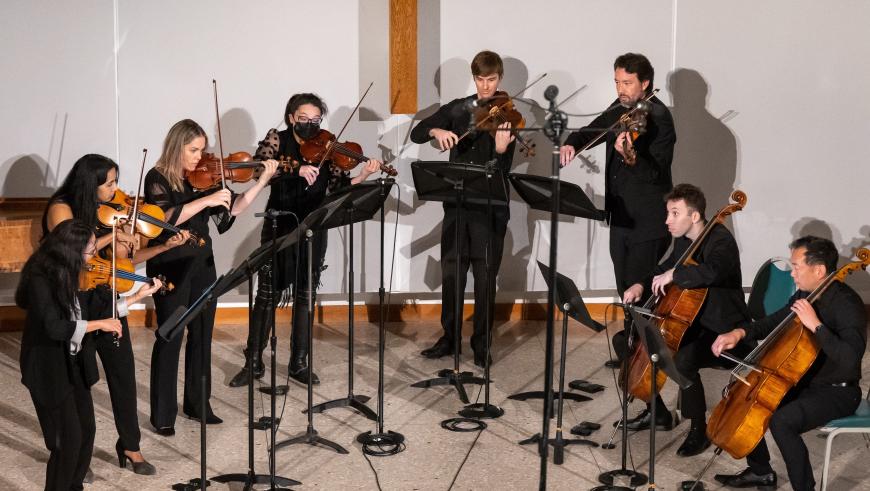
Expanding the instrumental formula, Thomas Kotcheff’s and through and through and through (2019) is a string octet that reflects the composer’s cross-referencing of Eastern and Western musical structures, tonalities, and microtonalities. The piece develops like a hare-and-hound race, with the players sliding from a safe haven of consonance into a microtonal series of chutes and ladders that whiz by in a flurry.
Jacaranda’s concert ended on a dramatic high note with Fantasmagoriana (2017) by Mark Grey. Before transforming Mary Shelley’s Frankenstein into an opera that premiered in 2019, Grey had turned his orchestral attention to that night in 1816 when Shelley and her friends set about to create modern tales of Gothic horror — of vampires and mad scientific experiments. It was a close encounter filled with storm and stress that Grey embodies in three contrasting movements conceived for string quintet, wind quintet, and percussion. Of all the works that evening, it was by far the most dramatic and theatrical as conducted by Vicki Ray.
If Jacaranda’s concert was wide-ranging, the final night of the Hear Now Festival was off the charts in its diversity of forms, inspirations, and instrumental vocabularies.
Still Images (2008) by Vera Ivanova is clearly rooted in Eastern European modernism. Memories become instrumental threads that interweave and stack one upon another into complex constructs reminiscent of György Ligeti. The large ensemble of UCLA Philharmonia Soloists was conducted by Neal Stulberg.
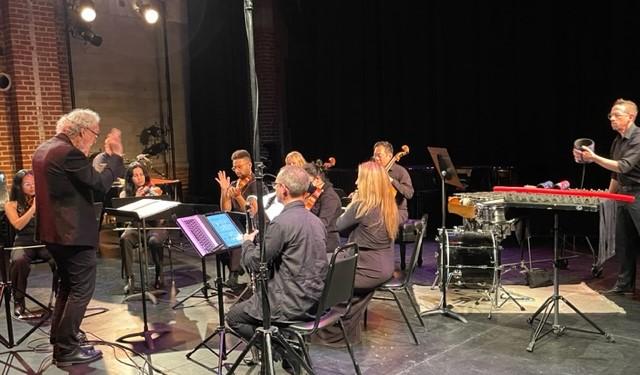
John Cage would have delighted in Carolyn Chen’s Our Glass Bodies (2016). After explaining how her piece was influenced by ancient Chinese medicine, Chen, accompanied by Eric KM Clark (violin), Jennifer Bewerse (cello), Dustin Donahue (percussion), and Nic Gerpe (piano), proceeded to create a work more soundscape than traditional composition that included glass spheres rolling around in saucers stirred with spoons, wine glasses on top of piano strings, and much, much more. It proved surprisingly immersive, once you surrendered to it.
A similar menagerie of instruments was incorporated into the exciting world premiere of Arash Majd’s wild kingdom of a piece, Continuum: Cause and Effect (2022). The composer explained the work as a series of orchestral snaps (literally) that provoke responses. But the pure joy of the piece is Majd’s evocation of a tropical rainforest filled with creeping, crawling, clicking, cawing, fluttering, and singing instrumental creatures. All it needed was Julie Taymor to stage it.
As her independent contribution, Huang presented 18 Melodies for Hujia, featuring soprano Stacey Fraser. A delicate balancing act between the traditional Chinese tonalities of her birthplace and the sounds of her adopted American homeland, Huang’s piece unfolds as an episodic saga that tells the story of Cai Wenji, who in the Han Dynasty was sold to the emperor as a concubine.
But it was when Huang spoke emotionally about the life she shared with her husband Bill Kraft that the entire weekend of musical experiences came full circle.



